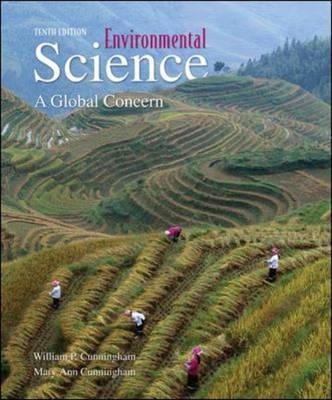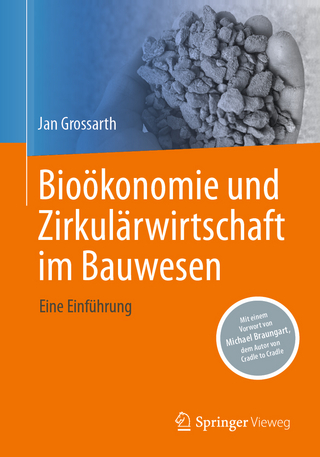
Environmental Science: A Global Concern
McGraw-Hill Professional (Verlag)
978-0-07-722122-5 (ISBN)
- Titel erscheint in neuer Auflage
- Artikel merken
Environmental Science: A Global Concern, Tenth Edition, is a comprehensive presentation of environmental science for non-science majors which emphasizes critical thinking, environmental responsibility, and global awareness. This book is intended for use in a one- or two-semester course in environmental science, human ecology, or environmental studies at the college or advanced placement high school level. The goal of this book is to provide an up-to-date, introductory global view of essential themes in environmental science along with emphasis on details and case studies that will help students process and retain the general principles. Because most students who will use this book are freshman or sophomore non-science majors, the authors make the text readable and accessible without technical jargon or a presumption of prior science background.
William Cunningham is an Emeritus Professor at the University of Minnesota where he taught for 36 years in the Departments of Botany and Genetics and Cell Biology as well as the Conservation Biology Program, the Institute for Social, Economic, and Ecological Sustainability, the Center for Environmental Learning and Leadership, and the McArthur Program in Global Change. He received his Ph.D. in Botany from the University of Texas in 1963 and spent two years at Purdue University as a postdoctoral fellow. At various times, he has been a visiting scholar in Sweden, Norway, Indonesia, and China, as well as several universities and research institutions in the United States.Dr. Cunningham has devoted himself to education and teaching development at the undergraduate level in biology. He began his educational career in structural biology but for the last 10-15 years has concentrated on environmental science, teaching courses such as Social Uses of Biology; Garbage, Government, and the Globe; Environmental Ethics; and Conservation History. Within the past four years, he has received both of the two highest teaching honors that the University of Minnesota bestows -- The Distinguished Teaching Award and a $15,000 Amoco Alumni Award. He has served as a Faculty Mentor for younger faculty at the university, sharing the knowledge and teaching skills that he has gained during his distinguished career. Mary Ann Cunningham teaches geography and geographic information systems (GIS), and environmental studies at Vassar College, Poughkeepsie, NY. Her research involves using GIS to assess landscape-level problems in conservation and biodiversity. In particular, she is interested in understanding the nature of fragmentation in grassland environments and the effects of fragmentation on the make-up of bird communities. The agricultural landscapes where she has been working represent a complex and fascinating interaction of issues concerning working landscapes, resource use, remnant wildlife habitat, and landscape aesthetics. It is at the intersection of these issues that she likes to try and understand the geography of physical environments. Mary Ann earned a PhD in Geography at the University of Minnesota, an MA in Geography at the University of Oregon, and a BA in Geology at Carleton College.
Learning to LearnPart One Principles for Understanding Our Environment1 Understanding Our Environment2 Frameworks for Understanding: Science, Systems, and Ethics3 Matter, Energy, and Life4 Evolution, Biological Communities, and Species Interactions5 Biomes: Global Patterns of Life6 Population BiologyPart Two People in the Environment7 Human Populations8 Environmental Health and Toxicology9 Food and Agriculture10 Pest ControlPart Three Understanding and Managing Living Systems11 Biodiversity12 Land Use: Forests and Grasslands13 Preserving and Restoring NaturePart Four Physical Resources and Environmental Systems14 Geology and Earth Resources15 Air, Weather, and Climate16 Air Pollution17 Water Use and Management18 Water PollutionPart Five Issues and Policy19 Conventional Energy20 Sustainable Energy21 Solid, Toxic, and Hazardous Waste22 Urbanization and Sustainable Cities23 Ecological Economics24 Environmental Policy, Law, and Planning25 What Then Shall We Do?
| Erscheint lt. Verlag | 16.11.2007 |
|---|---|
| Sprache | englisch |
| Maße | 229 x 279 mm |
| Gewicht | 1647 g |
| Themenwelt | Naturwissenschaften ► Biologie ► Ökologie / Naturschutz |
| Technik ► Umwelttechnik / Biotechnologie | |
| ISBN-10 | 0-07-722122-2 / 0077221222 |
| ISBN-13 | 978-0-07-722122-5 / 9780077221225 |
| Zustand | Neuware |
| Haben Sie eine Frage zum Produkt? |
aus dem Bereich



